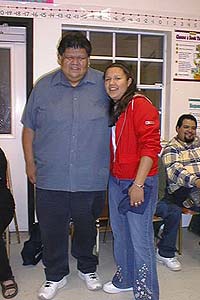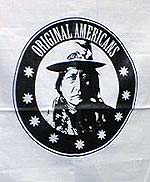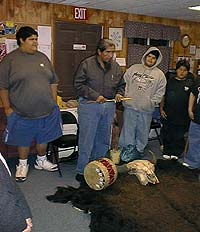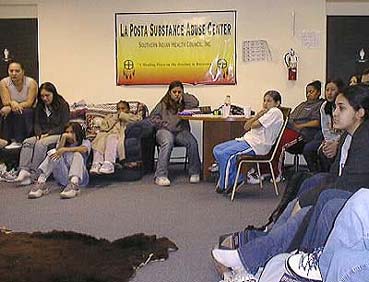|
Going home to the Rez, piling into
two bedrooms, Sitting Bull vs. Custer, and learning the Bird
Songs
CAMPO
RESERVATION, CALIFORNIA —
Matt
Singer: My name is Matt. I am a student at UC Berkeley. I eat
well and exercise often. I come from an upper-middle-class
family. My parents support me financially and emotionally.
I have never had a serious health problem. I have never encountered
a
serious obstacle in my pursuit of a college degree. I come
from a place of privilege. For these reasons, it has been
exceedingly difficult for me to comprehend the struggles faced
by young
Native
Americans as they pursue higher education and healthy lifestyles.
My experience on the Kumeyaay reservation changed all of this.
Van
Truong: I want to promote equal access
to higher education
for all students, and I came up with the idea of an Alternative
Break in a Native American community because that group is
tremendously underrepresented at the University of California.
We were able to get involved with
the Kumeyaay tribe through Sylvia Johnson, a Berkeley sophomore
and
a friend of mine.
I knew she was from Campo Reservation and that she could
be of great assistance. I discussed the
idea with Sylvia, she agreed to help, and the rest is history.
 |
| Sylvia
Johnson with Paul "Junior" Cuero, the reservation's
treasurer and lead Bird Singer. |
Sylvia Johnson: I
am a Kumeyaay Indian from Campo Indian Reservation in Campo,
California. I was born on the Rez,
moved away when
I was 2, and back when I was 14. Although I didn’t grow up
entirely in Campo, I still spoke the language and participated
in traditional events. I went to the alternative high school in
Campo for a while, but I didn’t like it for a bunch of different
reasons. I wasn’t challenged by my school work, so
I thought I would benefit more if I went to a high school
with
more opportunities.
My sophomore year I went to an all-Indian boarding school
in Riverside, California, called Sherman Indian High School.
Going
to Sherman
was probably the best thing that I could have done. I did
well in school all three years that I was there and got
a four-year
scholarship to Cal.
When Van first approached me about taking an alternative
break on an Indian Reservation, I was excited to help. Then
I started
to think about some of the problems with my people on the
reservation and how my people deal with certain things different
than other
people might. I thought that maybe the people on the reservation
might not take to this trip in a good way. But time went
by and I heard good things about this group of Cal students.
Louise Hon: When
I first heard of Alternative Breaks, I had doubts about
the program. It was designed for students to
provide "service" to
a community within a week’s time. That seemed like
an insurmountable task in the first place. After all, none
of
us are superheroes,
and with breaks such as the Kumeyaay one, we hardly have
enough knowledge about the issues to address the problems
in the community.
I can’t speak for others, but I definitely did not
feel ready when we hopped on the 15-passenger van that
Sunday morning.
After
10 hours of non-stop driving down to Campo, near San Diego,
I felt as lost and disoriented as I could be.
Van Truong: Sylvia’s
mother graciously opened up her home for us to stay. The
13 of us were a bit crowded in the
house;
however, we managed to sleep, cook meals, have meetings
and discussions for the entire week in this cozy home.
We occupied
the living
room,
two bedrooms and shared one bathroom for the duration of
the trip. It was like being in the dorms again, but much
more fun
and cozy.
DAY
ONE
Van
Truong: We met at the Campo Education Center,
which serves as an alternative high school and a community
center,
and
divided into three teams. One group helped prepare
lunch and facilitate
the Diabetic Education Class, a monthly nutritional
and diabetes-prevention class that teaches community members
about healthier ways
to eat and prepare meals; another group helped in the
day-care facility, while the third tutored students at the
Education
Center’s
alternative school.
Sylvia
Johnson: I was nervous because I was working
with my people but with a group of strangers from the outside.
I felt
kind of
weird at first, but the group seemed to be comfortable
in the situation, which made me comfortable as
well. I found
out a
lot about myself,
and about my community. There are some serious
issues on the reservation that I had no prior knowledge
of. A lot
of the
students are way
behind in school. I worked with a few students
that were in sixth or seventh grade and couldn’t read.
I had no idea that the kids on the Rez were that far
behind. I am glad that
we got
to
work with the students with all the things that
they struggle with.
 |
| A banner
hanging in the Educational Center. |
Louise
Hon: It was toward the end of our first day
of service, and I felt like I'd accomplished
very little,
aside from
tutoring math problems for about 40 minutes in
the morning with some
of the students at the alternative high school.
We were chatting with the few students that were around
and one
of them, Fred,
had on
a t-shirt whose front said "Our Heroes,
Your Enemies" and
listed prominent Native American figures such
as Sitting Bull, Crazy Horse and Geronimo. On
the
back it said, "Our Enemies,
Your Heroes" and listed Custer, Columbus,
Jackson, etc.
We
pulled an encyclopedia from the bookcase nearby and Frieda
[Kreth, a volunteer]
read the snippets
on Crazy
Horse and
Custer. They
were both described as young warriors and leaders,
but Crazy Horse was also described as "menacing." So
Frieda played devil’s
advocate and asked the students why people
like Crazy Horse were heroes and Custer wasn’t.
Fred and Danika and Marcus, other Native American
students, both knew their histories very well
and
defended the Natives' actions as self-defense
as opposed to the intention of the white "heroes" to
fulfill the idea of Manifest Destiny.
The
thing that stayed in my mind is how many lies can
be told in schools and through our
textbooks, but the
truth
will not
remain
hidden forever. Frieda was reprimanded by
several people for taking Custer’s side while
she was on an Indian reservation, but I think
she was smart and bold enough to challenge
people’s
ideas and continue to help students think
things through. For the rest of the week,
Fred called
her "Custer."
 |
Darren,
Dennis, Devon and
Aaron Alto prepare to sing a traditional Kumeyaay song. |
Van
Truong: In the evening, we prepared a large dinner for all
the youth and some of
the community
members.
The boys
and Paul
Cuero, the reservation's treasurer — a.k.a. "Junior" — sang
traditional Kumeyaay "Bird Songs" for
us. It's hard to describe what they sounded
like, but
they were
beautiful
and made
me want to cry, smile, laugh and shout
for joy all at the same time. One of the
girls,
Danika, showed
us how
to dance to them.
Paul also shared stories about the history
and culture of the Kumeyaay Indian.
DAY
TWO
Van
Truong: Again we met at the Campo Education
Center and divided into three
groups: to
help at the daycare
center, tutor at the
alternative school at the center, and
tutor another alternative high school
a few miles
away. Later that night
we joined
Dennis Alto, the outpatient coordinator
at the Youth Regional Treatment
Center, for the center's weekly Talking
Circle. The circle is basically a roundtable
discussion
for youth and people
struggling
with substance
abuse to talk about where they are
in life, any problems or obstacles they
were dealing
with — drugs,
alcohol, school, family or any other
matter.
Louise
Hon: Even at the treatment center, we were invited to share,
to
listen,
and to learn — despite the fact
that dependency on drugs or alcohol
has a lot of stigma attached to it
and is considered
a private issue in our society. It
gave me a chance to think about how
one person’s problem affects
everyone else and how the community
is so vital to a person’s well-being.

Alternative
Break volunteers and participants at the Youth Regional Treatment
Center's Outreach Program listen attentively during the Talking
Circle.
|





